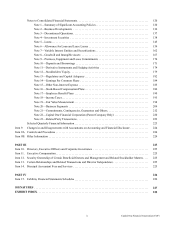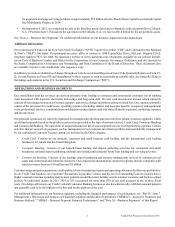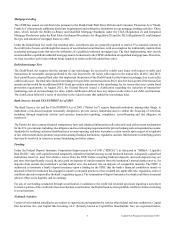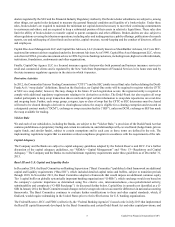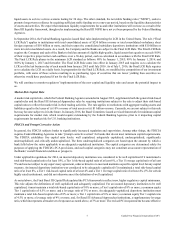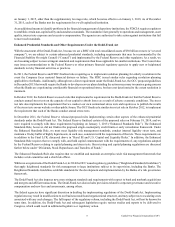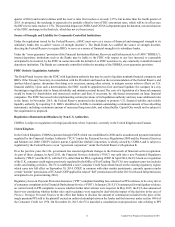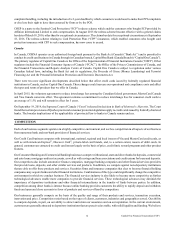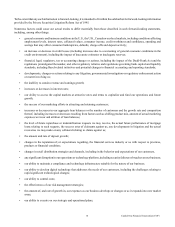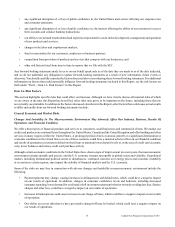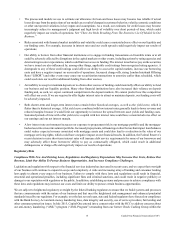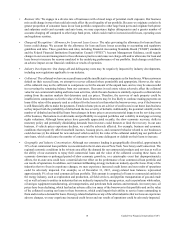Capital One 2015 Annual Report Download - page 27
Download and view the complete annual report
Please find page 27 of the 2015 Capital One annual report below. You can navigate through the pages in the report by either clicking on the pages listed below, or by using the keyword search tool below to find specific information within the annual report.8 Capital One Financial Corporation (COF)
on January 1, 2015, other than the supplementary leverage ratio, which becomes effective on January 1, 2018. As of December
31, 2015, each of the Banks met the requirements for a well-capitalized institution.
As an additional means to identify problems in the financial management of depository institutions, the FDICIA requires regulators
to establish certain non-capital safety and soundness standards. The standards relate generally to operations and management, asset
quality, interest rate exposure and executive compensation. The agencies are authorized to take action against institutions that fail
to meet such standards.
Enhanced Prudential Standards and Other Requirements Under the Dodd-Frank Act
With the enactment of the Dodd-Frank Act, because we are a BHC with total consolidated assets of $50 billion or more (a “covered
company”), we are subject to certain enhanced prudential standards, including requirements that may be recommended by the
Financial Stability Oversight Council (“Council”) and implemented by the Federal Reserve and other regulators. As a result, we
are becoming subject to more stringent standards and requirements than those applicable for smaller institutions. The Council also
may issue recommendations to the Federal Reserve or other primary financial regulatory agencies to apply new or heightened
standards to risky financial activities or practices.
In 2011, the Federal Reserve and FDIC finalized rules requiring us to implement resolution planning for orderly resolution in the
event the Company faces material financial distress or failure. The FDIC issued similar rules regarding resolution planning
applicable to the Banks. Additionally, although not a direct requirement under the Dodd-Frank Act, the OCC proposed guidelines
in December 2015 that would require the Banks to develop recovery plans detailing the actions necessary to remain a going concern
when the Banks are experiencing considerable financial or operational stress, but have not deteriorated to the extent resolution is
imminent.
In October 2012, the Federal Reserve issued a rule that implements the requirement in the Dodd-Frank Act that the Federal Reserve
conducts annual stress tests on the capacity of our capital to absorb losses as a result of adverse economic conditions. The stress
test rule also implements the requirement that we conduct our own semiannual stress tests and requires us to publish the results
of the stress tests on our website or other public forum. The OCC finalized a similar stress test rule in October 2012, to implement
the requirement that each of the Banks conduct annual stress tests.
In December 2011, the Federal Reserve released proposed rules implementing certain other aspects of the enhanced prudential
standards under the Dodd-Frank Act. The Federal Reserve finalized certain of the proposed rules on February 18, 2014, and we
were required to comply with these requirements beginning on January 1, 2015 (“Enhanced Standards Rule”). The Enhanced
Standards Rule, however, did not finalize the proposed single-counterparty credit limits or early remediation framework. Under
the Enhanced Standards Rule, we must meet liquidity risk management standards, conduct internal liquidity stress tests, and
maintain a 30-day buffer of highly liquid assets, in each case, consistent with the requirements of the rule. These requirements are
in addition to the Final LCR, discussed above in “Basel III and U.S. Capital and Liquidity Rules.” In addition, the Enhanced
Standards Rule requires that we comply with, and hold capital commensurate with the requirements of, any regulations adopted
by the Federal Reserve relating to capital planning and stress tests. Stress testing and capital planning regulations are discussed
further below under “Dividends, Stock Repurchases and Transfers of Funds.”
The Enhanced Standards Rule also requires that we establish and maintain an enterprise-wide risk management framework that
includes a risk committee and a chief risk officer.
While not a requirement of the Dodd-Frank Act, in 2014 the OCC issued regulatory guidelines (“Heightened Standards Guidelines”)
that apply heightened standards for risk management to large institutions subject to its supervision, including the Banks. The
Heightened Standards Guidelines establish standards for the development and implementation by the Banks of a risk governance
framework.
The Dodd-Frank Act also imposes new, more stringent standards and requirements with respect to bank and nonbank acquisitions
and mergers and affiliate transactions. The Dodd-Frank Act also includes provisions related to corporate governance and executive
compensation and new fees and assessments, among others.
The federal agencies have significant discretion in drafting the implementing regulations of the Dodd-Frank Act. Implementing
regulations may result in modifications to our business models and organizational structure, and may subject us to escalating costs
associated with any such changes. The full impact of the regulatory reform, including the Dodd-Frank Act, will not be known for
some time. In addition, the Dodd-Frank Act and subsequent legislation require various studies and reports to be delivered to
Congress, which could result in additional legislative or regulatory action.



